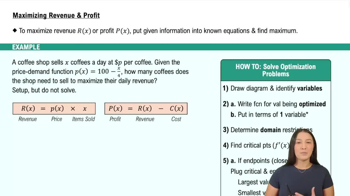Table of contents
- 0. Functions7h 52m
- Introduction to Functions16m
- Piecewise Functions10m
- Properties of Functions9m
- Common Functions1h 8m
- Transformations5m
- Combining Functions27m
- Exponent rules32m
- Exponential Functions28m
- Logarithmic Functions24m
- Properties of Logarithms34m
- Exponential & Logarithmic Equations35m
- Introduction to Trigonometric Functions38m
- Graphs of Trigonometric Functions44m
- Trigonometric Identities47m
- Inverse Trigonometric Functions48m
- 1. Limits and Continuity2h 2m
- 2. Intro to Derivatives1h 33m
- 3. Techniques of Differentiation3h 18m
- 4. Applications of Derivatives2h 38m
- 5. Graphical Applications of Derivatives6h 2m
- 6. Derivatives of Inverse, Exponential, & Logarithmic Functions2h 37m
- 7. Antiderivatives & Indefinite Integrals1h 26m
- 8. Definite Integrals4h 44m
- 9. Graphical Applications of Integrals2h 27m
- 10. Physics Applications of Integrals 2h 22m
5. Graphical Applications of Derivatives
Applied Optimization
Problem 4.5.16.b
Textbook Question
Pen problems
b. A rancher plans to make four identical and adjacent rectangular pens against a barn, each with an area of 100 m² (see figure). What are the dimensions of each pen that minimize the amount of fence that must be used? <IMAGE>
 Verified step by step guidance
Verified step by step guidance1
Define the variables: Let the width of each pen be 'w' meters and the length be 'l' meters. Since there are four pens, the total length along the barn is '4w'.
Set up the area equation: Each pen has an area of 100 m², so the equation for the area of one pen is 'w * l = 100'.
Express 'l' in terms of 'w': From the area equation, solve for 'l' to get 'l = 100 / w'.
Set up the perimeter equation: The total amount of fencing needed is the sum of the lengths of the sides not against the barn. This is '3l + 5w' (3 lengths and 5 widths).
Substitute 'l' in the perimeter equation: Replace 'l' with '100 / w' in the perimeter equation to get '3(100 / w) + 5w'. Simplify this expression to find the function of 'w' that represents the total fencing needed. Then, find the derivative and solve for 'w' to minimize the fencing.
 Verified video answer for a similar problem:
Verified video answer for a similar problem:This video solution was recommended by our tutors as helpful for the problem above
Video duration:
6mPlay a video:
Was this helpful?
Key Concepts
Here are the essential concepts you must grasp in order to answer the question correctly.
Optimization
Optimization in calculus involves finding the maximum or minimum values of a function. In this problem, the rancher seeks to minimize the total length of the fence while maintaining a fixed area for each pen. This requires setting up a function that represents the total fencing needed and using techniques such as derivatives to find critical points that yield the minimum value.
Recommended video:

Intro to Applied Optimization: Maximizing Area
Area and Perimeter Formulas
Understanding the formulas for area and perimeter is crucial in this problem. The area of each rectangular pen is given as 100 m², which can be expressed as length times width (l * w). The perimeter, or the amount of fencing needed, is determined by the dimensions of the pens, and the relationship between these dimensions must be established to solve the optimization problem effectively.
Recommended video:

Estimating the Area Under a Curve with Right Endpoints & Midpoint
Constraints
Constraints are conditions that must be satisfied in optimization problems. In this case, the area of each pen is a constraint that limits the possible dimensions of the pens. By incorporating this constraint into the optimization process, we can express one variable in terms of another, allowing us to reduce the number of variables and simplify the problem to find the optimal dimensions.
Recommended video:

Intro to Applied Optimization: Maximizing Area

 1:13m
1:13mWatch next
Master Intro to Applied Optimization: Maximizing Area with a bite sized video explanation from Callie
Start learningRelated Videos
Related Practice








